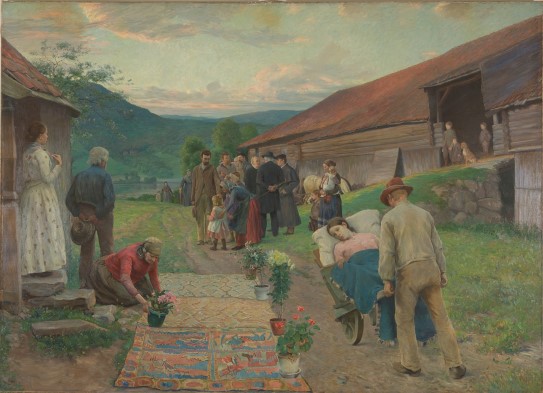The Son of Man
Christian Skredsvig
Transcription
Narrator:
When The Son of Man was put on display in Christian Skredsvig’s studio so that it could be shown to his fellow artists, the artist wrote to a friend:
“My large picture is biblical. It’s a free interpretation of: ‘And the people cast their clothes on the ground before him.’ But I’ve broken with tradition and shown him as an ordinary craftsman, as if it happened yesterday.”
So what are we looking at?
A Norwegian landscape, a farmyard. It’s towards the end of the day.
The women of the farmstead have laid their best rugs on the ground and we see a man dressed in humble working clothes entering the farmyard. He lays his hand on the head of a little girl, and coming towards them is a man pushing a sick young woman on a wheelbarrow.
People flock around the man, and more are on their way.
This craftsman in a farmyard, the Son of Man, Skredvig’s representation of Christ, has also been interpreted as a lay preacher — someone who preaches the word of God, but is not an ordained priest.
The Son of Man made its debut at the 'new Salon' in Paris in 1891. Several French critics were unsparing in their criticism, and the harshest review was in the French daily newspaper Le Soleil, which remarked that the person in worn clothing was “a kind of personification of a modern Jesus Christ, in the form of a leader of striking workers, a rabble-rouser from cheap pubs and busy roads, spreading belief in socialism.”
Today we can see Skredsvig’s enormous painting, the National Gallery’s largest work in its time, and agree with Professor Øystein Sjåstad’s statement, in his book about Skredsvig, that “The Son of Man” is one of Skredsvig’s very best works. Not only an important contribution to European religious painting in the last part of the nineteenth century, but also a masterpiece within the Norwegian art of the 1890s.”